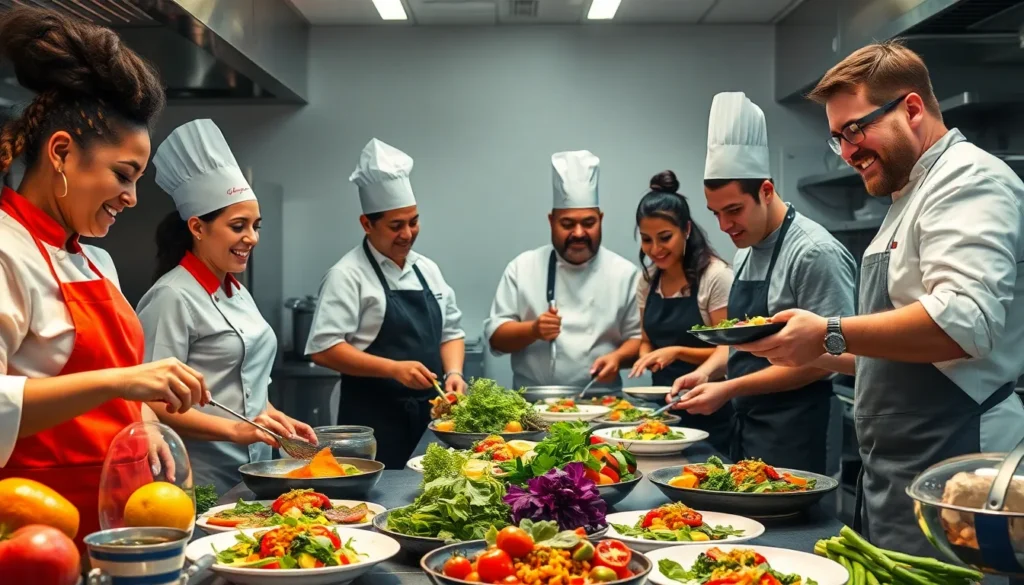The culinary world is constantly evolving, reflecting the tastes and values of society. As diners become more adventurous, chefs are pushing boundaries and experimenting with new flavors, techniques, and ingredients. From plant-based innovations to global fusion dishes, culinary trends are shaping how people experience food today.
In a landscape where health, sustainability, and creativity reign supreme, understanding these trends is essential for anyone passionate about food. Whether it’s the rise of zero-waste cooking or the popularity of ethnic cuisines, these movements not only influence restaurant menus but also home cooking. Exploring these trends reveals the dynamic relationship between culture and cuisine, highlighting how food can unite us in a diverse world.
Table of Contents
ToggleCurrent Culinary Trends
Culinary trends continue to evolve as chefs adapt to the preferences of modern diners. Key movements include plant-based innovations, global flavor influences, and a strong emphasis on sustainability.
Plant-Based Innovations
Plant-based innovations gain momentum as more diners embrace vegetarian and vegan options. Unique ingredients like jackfruit, aquafaba, and nutritional yeast provide creative solutions to traditional dishes. Chefs craft meals that highlight fresh fruits, vegetables, and whole grains, making nutritious and flavorful plant-based choices widely accessible. According to a report by the Good Food Institute, plant-based food sales reached $7 billion in 2021, reflecting a 27% increase over the previous year.
Global Flavor Influences
Global flavor influences shape menus around the world, as chefs experiment with diverse culinary traditions. Fusion dishes combining elements from various cuisines, like Korean tacos and sushi burritos, exemplify this trend. Diners crave authentic ethnic foods, prompting restaurants to explore flavors inspired by Mediterranean, Southeast Asian, and Latin American cooking. In a survey by the National Restaurant Association, 40% of chefs identified globally inspired dishes as a top trend for 2023.
Sustainability in Cooking
Sustainability in cooking emphasizes local sourcing and reduced food waste. Chefs adopt practices like farm-to-table sourcing, prioritizing fresh, seasonal ingredients from regional producers. Zero-waste cooking becomes increasingly popular, with chefs utilizing entire plants or repurposing kitchen scraps. A study from the Food Waste Reduction Alliance reveals that 30-40% of food in the United States is wasted, prompting a shift toward more conscientious cooking practices.
Technology in the Kitchen

Technology continues to reshape the culinary landscape, enhancing efficiency and creativity in cooking. Chefs and home cooks alike adopt innovative tools and resources to elevate their culinary experiences.
Smart Cooking Appliances
Smart cooking appliances simplify meal preparation and ensure consistent results. Devices like smart ovens and multi-cookers allow users to control cooking settings remotely through smartphones. Sous-vide machines provide precise temperature control for perfect meats and vegetables. Air fryers utilize rapid air circulation, offering healthier alternatives to traditional frying methods. According to a report by Statista, 58% of U.S. households own at least one smart kitchen device, highlighting the growing trend of tech integration.
Online Cooking Classes
Online cooking classes offer accessible education for culinary enthusiasts. Platforms like MasterClass and Udemy feature courses led by renowned chefs, covering various cuisines and techniques. Live-streamed sessions foster interactive learning, allowing participants to ask questions in real time. This accessibility promotes skill development and encourages experimentation in home kitchens. With the rise of digital platforms, the cooking class market is projected to reach $300 million by 2025, emphasizing the shift toward online culinary education.
Health-Conscious Eating
Health-conscious eating embodies choices that prioritize nutrition while aligning with contemporary dietary trends. Chefs and consumers emphasize ingredients that promote wellness and sustainability.
Functional Foods
Functional foods, packed with beneficial compounds, enhance health beyond basic nutrition. Ingredients like turmeric, rich in curcumin, offer anti-inflammatory properties. Berries, high in antioxidants, support heart health and cognitive function. Whole grains, such as quinoa and oats, provide fiber and essential vitamins. Fermented foods, including kimchi and yogurt, improve gut health through probiotics. These foods not only cater to health-conscious individuals but also appeal to those interested in holistic wellness.
Dietary Preferences
Dietary preferences continue to diversify, reflecting a growing awareness of health and sustainability. Plant-based diets gain traction, with nearly 9.7 million U.S. adults identifying as vegetarians and 3.3 million as vegans. Gluten-free options cater to individuals with celiac disease or gluten sensitivity. Intermittent fasting practices attract those seeking weight management and metabolic benefits. Additionally, the paleo and ketogenic diets promote low-carb, high-fat eating patterns. These dietary trends highlight a shift towards personalized nutrition, where each individual seeks a unique approach to health.
The Rise of Gourmet Fast Food
Gourmet fast food blends quality ingredients with quick service, catering to growing consumer demand for both convenience and culinary excellence. Chefs are now redefining traditional fast food with gourmet twists that elevate the dining experience.
Fusion Cuisine
Fusion cuisine merges techniques and flavors from different culinary traditions, generating innovative dishes that excite modern palates. Chefs incorporate elements from cultures worldwide, creating unique menus that feature items like Korean BBQ tacos or sushi burritos. This cross-cultural approach not only satisfies diverse tastes but also fosters a sense of global community. The popularity of fusion dishes reinforces diners’ desire for extraordinary experiences and encourages chefs to experiment with new combinations.
Artisanal Ingredients
Artisanal ingredients play a crucial role in gourmet fast food, showcasing locally sourced and handcrafted products. Chefs prioritize high-quality meats, artisan cheeses, and farm-fresh produce, enhancing flavor profiles and nutritional value. For example, burger patties made from grass-fed beef or gourmet buns crafted from organic grains exemplify this trend. Utilizing artisanal ingredients not only appeals to health-conscious consumers but also promotes sustainability, as local sourcing reduces the carbon footprint associated with food transportation. These quality components elevate standard fast food offerings, transforming them into memorable dining experiences.
The culinary landscape is thriving with innovation and creativity as chefs embrace modern dining trends. With a focus on sustainability and health-conscious options, the rise of plant-based ingredients and global flavors is reshaping menus everywhere. The integration of technology in cooking and education is also transforming how culinary enthusiasts engage with food.
As diners become more adventurous, the fusion of diverse cuisines and gourmet fast food is setting new standards for convenience and quality. This evolution not only enhances the dining experience but also fosters a sense of community among food lovers. The future of culinary trends promises exciting developments that will continue to inspire and delight palates across the globe.





